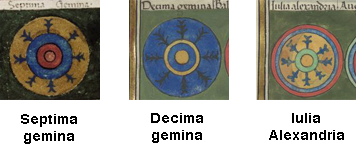
This page created 8 April 2014, and last modified: 26 November 2014 (Maier reference numbers added)

In the eastern half of the empire, the third of the nine units of legiones comitatenses listed (15.18 in Ingo Maier's numbering scheme) as being under the command of the Magister Militum per Orientem is called the Septima gemina. Its shield pattern (13#6) as shown in various manuscripts, under the matching label (13.f) Septima Gemina, is as below:

The shield pattern features a boss in red and maroon; which colour is on the inside depends on the manuscript (white replaces maroon in B). The boss is surrounded by a broad blue band (itself bordered by red in W); the main ground is yellow. Radiating out from the blue band are 8 blue somewhat plant-like motifs,; exactly what they are intended to represent is unclear.
The name Septimani clearly derives from one the legions numbered VII: the question is which one? The two possibilities are Legio VII Claudia under the Dux Moesiae primae, long stationed at Viminacium (near modern Kostalac in Serbia), and Legio VII Gemina Felix, long stationed at Legio (modern Leon in Spain). The name Gemina ("twinned") makes it clear the unit is derived from the Spanish legion. Other units that would seem to be derived from the same legion are the Septimani seniores, under the "Comes" Hispenias, and the Septimani iuniores, under the Comes Tingitaniae, since both of these units are stationed in what was the diocese of Hispania at the time the Notitia was compiled. In contrast, the Septimani (iuniores) in the Magister Equitum's Gallic command would appear to be a detachment of Legio VII Claudia. None of these various Septimani units have similar shield patterns, as the following comparison using the Parisian manuscript images makes clear:

The shield pattern of Septima gemina is, however, very similar to that of the next unit listed under the Magister Militum per Orientem, that of Decima gemina, as can be seen below from the following patterns taken from the Paris manuscript:

Given that the Decima gemina is clearly a detachment of Legio X Gemina, famed in Caesar's day, and long stationed in Vindomarae (Vienna), where a detachment is still recorded in the Notitia, the fact that it and Septima gemina have very similar shield patterns implies they had some more modern relationship together - perhaps being transferred at the same time into the command of the Magister Militum per Orientem, or perhaps slightly earlier, when other units that eventually found their way into the command were moved into Macedonia, such as the Secunda Flavia Constantia Thebaeorum, under the Magister Militum per Thracias, for example. That the Septima gemina and Decima gemina are the 3rd and 4th legions listed in the Magister Militum per Orientem's command implies they are a brigaded pair.
Also shown above is the only other similar pattern in the Notitia, that of the Iulia Alexandria, another of the legiones comitatenses under the Magister Militum per Thracias. The name of this unit suggests it was raised by the emperor Severus Alexander (whose powerful mother was named Julia) early in the 3rd century; it may well have received its pattern at the same time as the Septima gemina and the Decima gemina. Perhaps a fourth unit, formerly brigaded with the Iulia Alexandria was created at the same time, but had been lost or given a new shield pattern in the interim.

Return to the Notitia alphabetical unit list page.
Return to my Notitia index page.